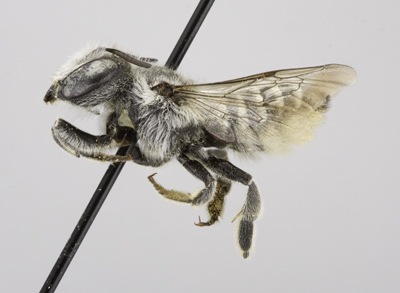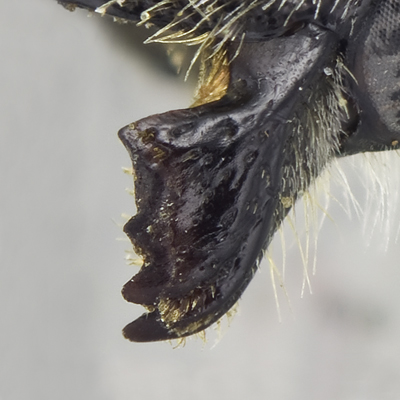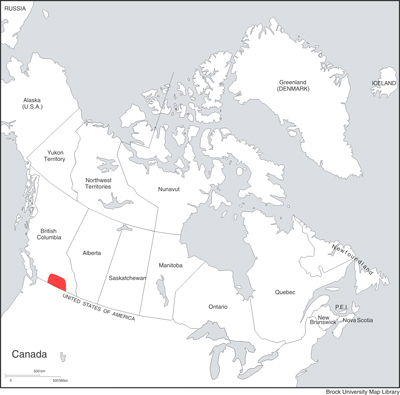
12. Megachile (Litomegachile) onobrychidis Cockerell, 1908
Megachile onobrychidis Female |
Megachile onobrychidis Male |
Megachle onobrychidis Cockerell, 1908a. Ann. Mag. Nat. Hist. (8) 1: 266 (♂).
Megachile perbrevis onobrychidis Cockerell, 1914. Ann. Mag. Nat. Hist. (8) 13: 431 (♂).
Diagnosis.The female of M. onobrychidis can be recognized by the combination of 4-dentate mandibles with the emargination between inner and 3rd teeth being approximately semicircular (i.e., its greatest depth subequally distant between the two teeth), T6 being distinctly concave in lateral view, and S6 with scopal hairs black. They are most similar to M. brevis and M. coquilletti. Females of M. brevis have the scopa on S6 mostly pale. Females of M. coquilletti have T6 weakly concave in lateral view. The male can be recognized by the combination of simple and dark front tarsi, front coxa possessing a small spine, 3-dentate mandibles, T5 with a white apical fascia, T6 with transverse carina weakly emarginate medially, with the surface above carina mostly dark, with very little white tomentum. They are most similar to M. brevis and M. coquilletti. Males of of both of these species have dense white tomentum on T6 above carina, concealing most of the surface beneath. Males of M. coquilletti have yellow front tarsi.
FEMALE: Length 9-12 mm.
Head:
Figure M12: Megachile onobrychidis female mandible |
1) compound eyes slightly convergent below; lateral ocelli slightly closer to margin of vertex than eyes (4:4.5), 2) clypeal margin nearly straight, median third narrowly shining and impunctate, 3) mandibles 4-dentate, with an incomplete cutting edge between 2nd and 3rd teeth, complete between 3rd and 4th teeth (Figure M12), 4) gena slightly narrower than compound eye (3:4), 5) punctures deep, distinct and rather coarse, slightly more separated between eyes and ocelli and on clypeus and supraclypeal area medially, closer between ocelli, across upper part of face, frons and lateral margins of clypeus, finer and more shallow and vague on gena, 6) pubescence white, rather copious around antennae and paraocular area, and on gena, especially below, largely black on vertex, 7) F1 as long as broad, subequal in length to pedicel and remaining flagellomeres, apical flagellomere more elongate (3:7).
Mesosoma:
1) pubescence white, rather copious laterally and posteriorly, scutummesoscutum with interspersed black pubescence, less so on scutellum, 2) punctures of mesoscutum close, moderately coarse throughout, those on axilla and scutellum somewhat closer and finer, shallow and rather densely crowded on pleura, propodeum somewhat smoother, punctures very fine, shallow and indistinct, triangle relatively dull and impunctate, 3) mid and hind basitarsi nearly as broad as their tibiae, spurs yellowish, 4) tegula minutely and rather closely punctate, 5) wings subhyaline, becoming faintly clouded along apical margin, veins black.
Metasoma:
1) T2-T5 shallowly grooved or depressed toward basal margins, apical margins more abruptly depressed laterally, rims very narrowly yellowish-hyaline; T1 with copious, elongate, erect, whitish pubescence, discal pubescence of T2 somewhat shorter but entirely whitish, that on T3-T5 black in part just basal to apical fasciae, T2-T5 with entire, whitish, apical fasciae; punctures close and fine on T1 and T2, somewhat more widely separated on T3-T5, dense on T6; T6 distinctly concave in profile with a distinct apical lip, with rather abundant, erect black pubescence, without pale tomentum, 2) scopa yellowish-white on S2-S5, entirely black on S6, usually with a few black hairs in the scopa of S5 laterally or apically, apical margin of S6 with a dense fringe of short, more brownish hairs; sternal plates quite coarsely and closely punctate, narrowly yellowish-hyaline apically.
MALE: Length 7-9 mm.
Head:
1) compound eyes slightly convergent below; distance from lateral ocelli to eyes subequal to distance to margin of vertex, 2) clypeal margin nearly straight, but impunctate median area very slightly in-curved, surface obscured by a dense, elongate, white pubescence, 3) mandibles conspicuously 3-dentate, lower process acute, subbasal in position, 4) gena slightly narrower than compound eye (4:5), 5) punctures deep and distinct with shiny interspaces <1 pd laterally on vertex, rather close medially on vertex and between eyes and ocelli, becoming very fine, close and obscure on the more shining gena, rather coarse and quite closely crowded on frons, but becoming minute and densely crowded on supraclypeal area and paraocular area beneath pubescence, but upper half of clypeus with distinct, rather coarse and quite close punctures evident, these becoming minute and densely crowded apically where surface is obscured by pubescence, 6) pubescence largely pale yellow to white on head, quite copious and erect around antennae, on sides of face and on clypeus apically, elongate and quite copious on gena below, somewhat sparser but erect and quite copious on vertex, 7) F1 about as long as broad, and shorter than pedicel, remaining flagellomeres longer than broad (3:2), apical flagellomere narrow and elongate, twice as long as broad.
Mesosoma:
1) pubescence largely pale, with only a few yellowish hairs intersmixed on mesoscutum, elongate and quite copious laterally and posteriorly, somewhat thinner but erect and quite copious on dorsal surface, 2) punctures quite deep, distinct and close over most of mesoscutum and scutellum, relatively fine, slightly separated along mid-line of scutellum, quite densely crowded and fine on pleura, propodeum somewhat more shining, triangle dull and impunctate, 3) front coxal spine well developed but rather short, subacute, quite densely long pubescent; all basitarsi much narrower than their tibiae, spurs yellowish-brown, 4) tegula minutely and rather closely punctate, 5) wings subhyaline, veins brownish-black.
Metasoma:
1) T2-T5 quite deeply depressed toward basal margin, T3-T5 with a basal fasciae of subappressed white hairs; apical margins narrowly and abruptly depressed, more deeply so laterally, margins narrowly yellowish-hyaline, with whitish fasciae; discal pubescence copious and erect on T1 and T2, somewhat shorter but erect and rather conspicuous on T3-T5, yellowish, becoming darker laterally on T3-T5; T1 and T2 very closely and finely punctate, punctures more distinctly separated and somewhat coarser on T3 and T4, quite coarse and close over T5; T6 with very sparse, whitish tomentose area hardly obscuring surface, carina with a small, median emargination that is obscured by the irregular, more lateral crenulations, median teeth of apical margin nearer lateral teeth than to each other, 2) S1-S4 exposed, apical margins depressed and yellowish-hyaline, conspicuously fringed with elongate, pale hairs; punctures close and fine on S1 and S2, somewhat coarser and more widely separated on S3 and S4.
Genitalia: Figure G12.
|
Figure G12: Megachile onobrychidis genitalia |
Discussion:
Although Megachile onobrychidis is often considered a subspecies of M. brevis, to which it is closely related, it is recognized here as a valid species based on 5.47% sequence divergence in COI, and morphological differences outlined above (see M. brevis). This species probably nests in the ground (Table 1).
Distribution:
Eastern Canada in QC and ON and BC in the west (see Map 11).
|
Map 12: Canadian distribution of Megachile onobrychidis |




